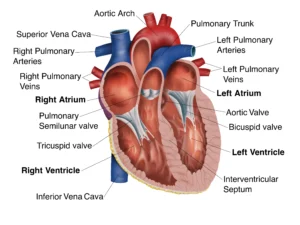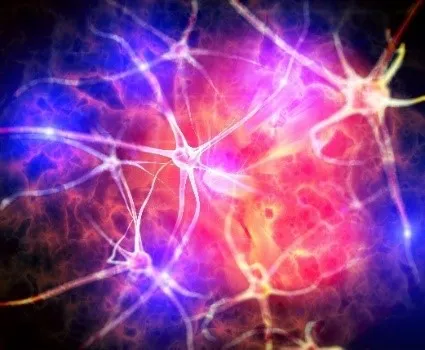Taking Cardiovascular Health to Heart this American Heart Month
February is American Heart Month—an opportunity to spotlight cardiovascular health and the prevention of heart disease.
 This February marks the 58th anniversary of American Heart Month, which was first established by President Lyndon B. Johnson—himself a heart attack survivor. “The health of our heart has a great impact on our overall wellness and physical capacity,” says Dr. Kenneth J. Olson, Clinic Director of Anodyne Pain & Wellness Solutions in Aurora, Illinois. “Heart health awareness is the first step in taking action to improve heart health, and making positive choices day in and day out leads to long-term change.”
This February marks the 58th anniversary of American Heart Month, which was first established by President Lyndon B. Johnson—himself a heart attack survivor. “The health of our heart has a great impact on our overall wellness and physical capacity,” says Dr. Kenneth J. Olson, Clinic Director of Anodyne Pain & Wellness Solutions in Aurora, Illinois. “Heart health awareness is the first step in taking action to improve heart health, and making positive choices day in and day out leads to long-term change.”
Although the field of cardiovascular medicine has made significant strides since America’s first Heart Month in 1964, heart disease continues to be the nation’s leading cause of death—with 1 in every 4deaths attributed to the disease each year. Tragically, every 36 seconds, cardiovascular disease claims a life. Despite being one of the most deadly and costly diseases, heart disease is also one of the most preventable. Understanding the anatomy of the heart is an essential step toward supporting its health.
Heart to Heart: Cardiovascular Anatomy

Remarkably, the heart beats more than 2.5 billion times over a 70-year lifetime. A muscular organ, the heart is the centerpiece of our circulatory system, a network of blood vessels (e.g., arteries, veins, and capillaries) that carry oxygen and nutrients to our cells. The heart comprises four chambers—two atria and two ventricles. Arteries carry blood away from the heart and veins carry blood to the heart. Valves within the heart control the flow of blood through these blood vessels as well as the heart’s four chambers. Blood flows through the heart and lungs in four main steps. First, the heart’s right atrium receives oxygen-deficient, carbon dioxide-rich blood, which is pumped to the lungs by the right ventricle. In the lungs, oxygen is added to blood and carbon dioxide is removed. The left atrium then receives the oxygen-rich blood and pumps this blood to the left ventricle. Finally, the left ventricle—the strongest of the chambers—pumps this oxygen-rich blood out to the rest of the body. Ultimately, in a healthy heart, each of the four chambers works together seamlessly to keep a continuous flow of oxygen-rich blood circulating throughout the body.
Each contraction of the heart’s muscle tissues is highly controlled. Rhythmic electrical impulses flow through the heart in an exact way, along distinct routes, at a controlled speed. Impulses originate in the heart’s natural pacemaker, which generates a tiny electrical current. As the electrical impulse moves through the heart, the heart contracts—with each contraction representing one heartbeat. A healthy heart delivers the right amount of oxygenated blood at the right rate. If the heart’s electrical system is dysfunctional or if the heart is weakened by disease or injury, the heart isn’t able to effectively pump enough blood for our organs to function properly.
Heart of the Matter: Cardiovascular Disease
Cardiovascular disease—a catch-all term for diseases affecting the heart and blood vessels—encompasses a range of conditions affecting the heart including blood vessel diseases (e.g., coronary artery disease), heart rhythm problems, heart valve diseases (e.g., rheumatic heart disease), stroke, congestive heart failure, and heart attack.
Many diseases and complications of the heart develop with the onset of a condition known as atherosclerosis. Atherosclerosis develops when plaque builds up along the walls of the arteries. This buildup narrows the arteries—restricting blood flow, and in some cases, leading to blood clots. If a blood clot forms and an artery supplying the heart with blood and oxygen becomes blocked, part of the heart muscle dies, and a heart attack occurs. 
Heart attack is often mistakenly equated to congestive heart failure. However, contrary to what its name implies, heart failure is not the stopping of the heart. Rather, a heart afflicted with congestive heart failure continues working, but does not adequately pump blood.
The heart’s ability to effectively pump blood is also impacted by arrhythmias, or abnormal heart rhythms—heartbeats that are too slow, too fast, or irregular. An irregular heartbeat may mean that the heart is not able to pump enough blood to meet the body’s needs.
The heart also can suffer from valve diseases in which one or more heart valve doesn’t function properly. If one or more valves doesn’t open or close, blood flow through the heart is disrupted.
Knowing the Risk Factors by Heart
Heart disease can happen at any age. In fact, an increasing number of young adults are experiencing heart disease because many of the conditions and behaviors that make people at risk for heart disease are appearing in younger populations. “Not long ago, heart attacks were primarily experienced in ‘older’ adults. Now, one in five heart attack patients are younger than 40 years old,” says Olson. “Having a heart attack in your 20s and 30s is more and more common. In fact, between 2000 – 2016, in this age group, the rate of heart attack increased by 2% every year.”
According to the Centers for Disease Control and Prevention, nearly half of all Americans have at least one of the top three risk factors for heart disease: high blood pressure, high cholesterol, or tobacco use. High blood pressure damages the arte
ries by making them less elastic, which ultimately decreases the flow of blood and oxygen to the heart. High cholesterol levels can lead to fatty deposits in the blood vessels, which make it difficult for enough blood to flow through the arteries. Smoking greatly impacts the heart and blood vessels by increasing blood pressure and heart rate, reducing blood flow from the heart and the amount of oxygen reaching bodily tissues, increases the risk for blood clots, and damages blood vessels.
 In addition to high blood pressure, high cholesterol, and tobacco use, factors that increase the likelihood of developing heart disease include obesity (extra weight puts stress on the heart), high blood sugar levels (sugar buildup in the blood can damage blood vessels and nerves that control the heart muscle), physical inactivity (fatty material can build up in the arteries), and unhealthy diet patterns (diets high in sodium and sugar increase blood pressure and can damage arteries).
In addition to high blood pressure, high cholesterol, and tobacco use, factors that increase the likelihood of developing heart disease include obesity (extra weight puts stress on the heart), high blood sugar levels (sugar buildup in the blood can damage blood vessels and nerves that control the heart muscle), physical inactivity (fatty material can build up in the arteries), and unhealthy diet patterns (diets high in sodium and sugar increase blood pressure and can damage arteries).
Take Heart: The Power of Prevention
Healthy lifestyle choices can have a profound impact preventing cardiovascular disease. Adopting a few healthy habits such as avoiding tobacco, moderating alcohol consumption, making balanced and nutritious meal choices, and staying active can help prevent or treat conditions that lead to heart disease. In fact, according to a 2020 study cited by the Cleveland Clinic, more than two thirds of heart disease-related deaths worldwide can be linked to food choices. Olson notes the significant impact of lifestyle choices on heart health. “Every positive choice is a deposit in your health account, and every negative choice is a withdrawal,” says Olson. “We need to be making far greater deposits to our health, and lifestyle is one of the easiest ways to make more deposits. At Anodyne, we focus on your physical and musculoskeletal health—knowing that by decreasing pain, managing physical stress, increasing exercise capacity, and improving strength and stamina, we can help patients make more deposits in their health accounts and improve overall wellbeing.”
To learn more about Anodyne Pain & Wellness Solutions’ collaborative and holistic approach to patient weight loss visit https://anodynepain.com/ today.
Related Articles
Whether you’re struggling to diagnose a chronic pain condition or you’re pursuing wellness treatments to stay healthy and feel great, we’re here to support you at every step of your health care journey.
